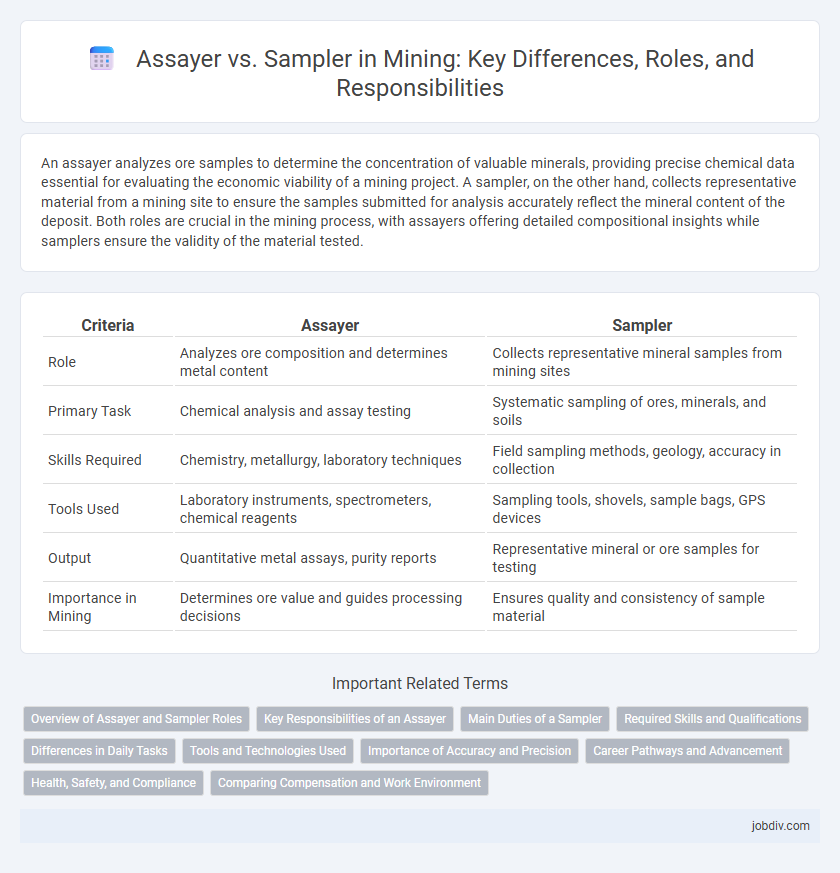An assayer analyzes ore samples to determine the concentration of valuable minerals, providing precise chemical data essential for evaluating the economic viability of a mining project. A sampler, on the other hand, collects representative material from a mining site to ensure the samples submitted for analysis accurately reflect the mineral content of the deposit. Both roles are crucial in the mining process, with assayers offering detailed compositional insights while samplers ensure the validity of the material tested.
Table of Comparison
| Criteria | Assayer | Sampler |
|---|---|---|
| Role | Analyzes ore composition and determines metal content | Collects representative mineral samples from mining sites |
| Primary Task | Chemical analysis and assay testing | Systematic sampling of ores, minerals, and soils |
| Skills Required | Chemistry, metallurgy, laboratory techniques | Field sampling methods, geology, accuracy in collection |
| Tools Used | Laboratory instruments, spectrometers, chemical reagents | Sampling tools, shovels, sample bags, GPS devices |
| Output | Quantitative metal assays, purity reports | Representative mineral or ore samples for testing |
| Importance in Mining | Determines ore value and guides processing decisions | Ensures quality and consistency of sample material |
Overview of Assayer and Sampler Roles
Assayers analyze ore samples to determine metal content and purity, using techniques like fire assay and atomic absorption spectroscopy for precise mineral valuation. Samplers collect representative material from mining sites, ensuring that samples reflect the true composition of the mined ore through systematic sampling methods. Both roles are critical in the mining process, supporting accurate resource estimation and quality control.
Key Responsibilities of an Assayer
An assayer is responsible for analyzing ore and mineral samples to determine their composition and metal content through chemical, metallurgical, and instrumental techniques. They ensure accurate assay data by preparing samples, conducting tests, and interpreting results critical for evaluating the economic value of mined materials. Unlike samplers who collect representative material from mining operations, assayers perform laboratory analysis crucial for quality control and resource estimation in the mining industry.
Main Duties of a Sampler
Samplers are responsible for collecting representative samples of ore, soil, or rock to ensure accurate analysis of mineral content and grade distribution. Their main duties include selecting sampling sites, extracting samples using appropriate tools, and maintaining sample integrity during transport to laboratories. Accurate sampling is crucial for providing reliable data that supports effective mine planning and resource estimation.
Required Skills and Qualifications
Assayers require strong analytical chemistry skills, proficiency in laboratory techniques, and knowledge of mineralogy to accurately determine metal content in ore samples. Samplers need expertise in field sampling methods, attention to detail, and understanding of geological formations to collect representative samples for testing. Both roles demand technical training, safety awareness, and relevant certifications in mining or metallurgical disciplines.
Differences in Daily Tasks
Assayers analyze ore samples in a laboratory setting to determine the metal content and quality, using techniques like fire assay and spectrometry. Samplers collect representative physical samples directly from mining sites or stockpiles to ensure accurate testing and consistent quality control. While samplers focus on precise sample collection, assayers concentrate on detailed chemical analysis and reporting of mineral value.
Tools and Technologies Used
Assayers utilize advanced analytical instruments such as inductively coupled plasma mass spectrometry (ICP-MS) and X-ray fluorescence (XRF) to determine the precise composition of ore samples. Samplers rely on tools like pneumatic rock drills, core barrels, and portable sampling kits to collect representative mineral specimens from various mining sites. Both professions leverage GPS mapping and digital logging technologies to enhance accuracy and traceability in the mineral extraction process.
Importance of Accuracy and Precision
Accuracy and precision in assaying and sampling are critical for reliable mineral resource estimation and economic viability assessments. An assayer's role involves precise chemical analysis of ore samples to determine metal content, while a sampler ensures representative collection from the deposit, minimizing sample bias. High accuracy and precision directly impact decision-making in mine planning, resource classification, and investment risk reduction.
Career Pathways and Advancement
Assayers specialize in analyzing mineral content and chemical compositions, often advancing into roles such as laboratory managers, metallurgists, or quality control supervisors due to their technical expertise. Samplers focus on collecting representative mineral samples from mining sites, with career progression leading to positions like field supervisors, mining engineers, or environmental compliance officers because of their hands-on experience. Both career paths offer opportunities for advancement through certification, technical training, and gaining industry-specific knowledge.
Health, Safety, and Compliance
Assayers and samplers play critical roles in mining, with assayers analyzing mineral content to ensure compliance with regulatory standards and samplers collecting representative samples while adhering to strict health and safety protocols. Effective collaboration between assayers and samplers minimizes exposure to hazardous materials and reduces risks associated with contamination or inaccurate results. Compliance with industry regulations, such as those mandated by MSHA and OSHA, relies on rigorous sampling techniques and precise assay methods to protect worker health and maintain operational integrity.
Comparing Compensation and Work Environment
Assayers typically receive higher compensation than samplers due to their specialized skills in analyzing mineral content and providing precise assay results vital for mine valuation. The work environment for assayers is often lab-based, involving detailed chemical analysis and quality control, whereas samplers operate primarily in the field, collecting ore or soil samples under diverse and sometimes harsh mining conditions. Both roles are essential to mining operations but differ significantly in pay scale and work setting, reflecting their distinct responsibilities and technical demands.
Assayer vs Sampler Infographic

 jobdiv.com
jobdiv.com